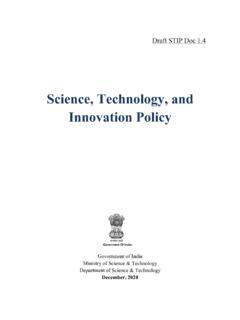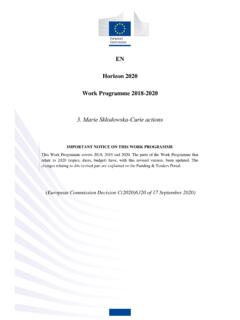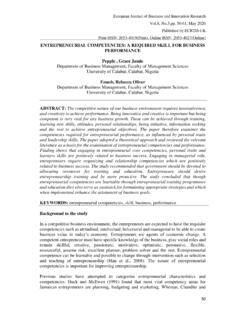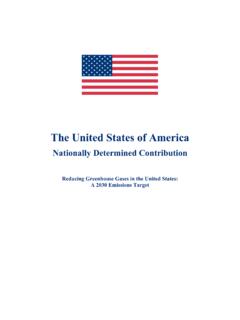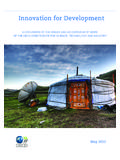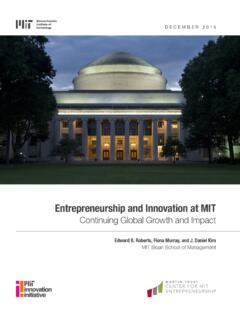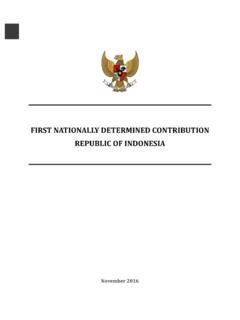Transcription of Sustainable Innovation: Drivers and Barriers.
1 Dearing/OECD TIP workshop Page 1 Sustainable innovation : Drivers and DearingWorld Business Council for Sustainable Development4 chemin de Conches1231 often describe Sustainable development as requiring a joint andlong-term outlook by society that integrates social, economic andenvironmental objectives. Today, the private sector s contributions comefrom developing and using environmentally better, eco-efficient, ways toproduce and provide products and services and by creating wealth andemployment respectful of changing expectations of corporate responsibilityand and extending this contribution beyond eco-efficiency dependsupon the continued innovation that effective design and the development anduse of better technologies will make possible. Sustainable development is ametaphor for opportunity and progress as well as a reminder of obligationsand uncertainty.
2 It requires a step-change improvement in doing better what we are already doing is not sufficient to meet theneeds and aspirations of a growing world population with the same time, commercial success depends upon carrying out business invalue-creating ways. Increasingly, the World Business Council forSustainable Development (WBCSD) believes that this can be achieved byaddressing innovative opportunities that reflect changing socialexpectations and support a transition to greater sustainability. Whereasour research suggests that no single approach will apply to all firms inall situations, some common underlying principles emerged, which aresummarized Sustainable development offers an organizing framework based onopportunity and respect for human values. innovation is about using changeto better meet human needs and values. The connection seems obviousalthough it is hard to realize in the absence of clear market signals and acommon language, especially since innovation can come unexpectedly out ofleft field and have uncertain Better design and new technologies provide the means to act smarterand more sustainably but this technology also creates uncertainties, forexample about the consequences of the scale and scope of application.
3 Usingthese tools well depends upon understanding what the public is expectingand being able to meet these needs cost-effectively and without raisingalarms and The process of innovation is taking place within increasinglynetworked economies with changing social values and growing environmentalpressures. While these forces are unavoidable, they are not commercial approaches depend on having the flexible,multidisciplinary skills to respond to this changing context. Sustainabledevelopment is not unusual in this TIP workshop Page 24. Within developing nations in particular, technology s contribution tosustainable development comes largely through business-to-businesstransactions. Here, the large gap in performance is typically not aconsequence of the lack of cost-effective technologies. The priority is toincrease the capacity to apply available solutions well.
4 Key focus areasare to develop skills and capacity especially in the small-and-mediumenterprise (SME) sector and to find ways to reduce project investment Development Assistance (ODA), Foreign Direct Investment (FDI) andthe newer flexible market instruments such as the Clean DevelopmentMechanism can be brought together to support innovative and effectivepublic-private partnerships to address these In some situations, people respond best to Sustainable development asa vision, whereas in others, more pragmatic approaches work best. Whicheverapproach is preferred, innovation often comes from facing strategicdilemmas that can only be resolved by finding new approaches. This is onereason why credible stretch targets can be an effective way to secure The leadership task is to harness economic and social trends, capturethe tremendous amount of knowledge and experience that exists in networksworldwide and combine these in ways that command respect, generateenterprise and create value.
5 Traction is likely to be greatest when themanagement approach is positioned appropriately for the company in itsnetwork and seen by staff to be relevant and self-evident, if not simple,in purpose and content. This needs clear direction backed up by resources,management support and good We believe that achieving this requires extending the principles oftransparency and learning, corporate social responsibility and eco-efficiency throughout the innovation process. This process extends fromresearch and development through technology selection and use, product andservice design, investment and employment policies and global and localbusiness activities, as well as to issues management and summary, the commercial challenges are to learn to treat sustainabledevelopment as a framework for innovation and to use and extend establishedmanagement principles to make this framework operational and , leading companies have demonstrated the willingness to expresswhat they stand for and in turn understand what society expects of companies are actively developing and incorporating the tools toimprove performance across the three pillars of Sustainable are learning how to stimulate innovation and are setting focusedtargets that measure progress and assure the link between their own valuesand those of their customers.
6 But there is much more to be done andimportant lessons to be learned and applied, especially to obtaininnovation that addresses the social pillar of Sustainable are many ways in which other stakeholders can assist these example, governments can design regulatory frameworks that set thedirection, encourage and reward the experimentation that fosters innovationand improves sustainability. They can demonstrate (through procurementpolicies and the information provided to the public) that they arecommitted to achieve the same objectives being expected of TIP workshop Page 31. innovation and Sustainable DevelopmentFirms have used technology as an engine of progress since at least the timeof the Industrial Revolution, which gave remarkable ways to marshal thephysical world for human benefit. innovation , which we use to mean thesuccessful implementation of new developments and ideas, depends upon muchmore than technological advance, but technology has consistently providedthe opportunities from which to make and sell better goods and services andto do so more cleanly and more of today s social and economic developments are a result of technicaldiscoveries and developments in fields such as communications, informationprocessing, health sciences and energy supply.
7 These promise smarter, moretailored solutions to the tasks we wish to accomplish. Rather than beingmonolithic in approach, the tools are used by dynamic and responsivenetworks of small and large, public and private organizations, workingtogether and in competition in ways that were never before changes are tremendous and the opportunities profound, but it hasbecome clear that technology can only be part of achieving a moresustainable development and its contribution is not always as positive aswe might wish. Furthermore, other factors that can drive and supportprogress are themselves changing and need to be example, the well-defined social categories for which post-war Westerninstitutions were designed no longer fit well with people s aspirations andvalues. Richer countries are experiencing a shift towards an increasinglymultidimensional and diverse Mosaic Society , with uncertain needs butvery real concerns about many subjects including science and technology.
8 Atthe same time, despite there being greater affluence than at any time inhistory, most of the world s population remains poor yet increasingly awareof its relative poverty. For these people, the economic and social benefitsof globalization and global markets are increasingly being other writers have offered cogent, visionary ideas of the improvedsustainability that can be obtained by marshaling recent developments. Thefocus of this paper is on how firms can organize themselves to realizethese opportunities in ways that will benefit and be acceptable to societyand also create the value that permits them to remain in approach that is suggested is based on understanding how companies havehandled the concepts of corporate social responsibility and eco-efficiency,examining how they are now managing innovation and technology and findingways that will bring these approaches together in today s and tomorrow companies have built their approaches to Sustainable developmentupon principles that can be summarized as follows: Ensuring the corporation understands what society expects of it, inreturn expressing clearly what the firm itself stands for, thenreinforcing these values in ways that stretch the organization and createa spirit of continuous improvement.
9 (Attitude) Developing the tools and approaches to improve performance across thesocial, environmental and economic pillars of Sustainable development andincorporating these tools within routine business processes. (Build thecapacity to act)Dearing/OECD TIP workshop Page 4 Setting focused targets and putting in place the means to measureperformance and confirm that the targets are being achieved. (Checkprogress)For existing business operations undergoing normal business development,these are mutually reinforcing principles. They provide a positive andeffective framework that firms can use in mitigating environmental impactand allaying public twenty years ago, most companies based performance standards onregulatory requirements, today many choose to go beyond regulation becausethey see commercial benefit in doing so. Established practice in areas suchas safety and quality management has demonstrated that uncompromisingprinciples are perfectly compatible with the spirit of dialogue now helps firms learn more about others points ofview and then use this understanding to set better priorities and move awayfrom confrontational approaches.
10 In extending systems of financial controland audit to cover environmental impact, they have recognized the need togain early buy in by ensuring relevance to the specific priorities ofindividual business units. Technology is playing a central role byproviding the means to move forward and engineers generally seem to relishthe opportunity to find more eco-efficient solutions once the parametersfor improvement have been established and stock market returns achieved by those companies included in therecently launched Dow Jones Sustainability Index suggest that investors arenow recognizing the management qualities that have made this Enough or Could Do Better?This is intended to be a rhetorical question. During the last decade, thearguments and counter-arguments about rates of improvement have been wellrehearsed. Economic focus leads to short-termism . Regulatory frameworksoffer too much (or too little) command and control , so we are notproperly pricing public goods, environmental services and social wellbeing.










